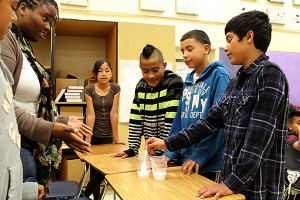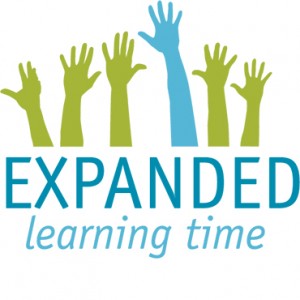
Jairo Martinez and seventh grade classmates in a summer program at Coliseum College Prep Academy in Oakland talk to their teacher, Toynessa Kennedy, about chemical reactions. Credit: Lillian Mongeau, EdSource Today
While summer classes targeted at struggling students are nearing extinction on many school campuses, several districts are rebooting the traditional summer education model by blending academics with recreational activities intended to prevent students from falling even further behind.
Unlike traditional summer classes that districts had to pay for out of their own budgets, these programs are funded with help from federal and state initiatives or grants from philanthropic foundations. Many of the programs are typically offered in partnership with nonprofit groups, some of which have already been working on campuses to provide after-school programs during the regular school year.
These summer programs are being reinvisioned as a way to use the school break time more effectively to help close academic achievement gaps between more affluent and poor students. In contrast to traditional remedial summer classes, these “enrichment” programs focus on fun, engaging activities – with a strong educational component – to keep student interest high.
Traditional remedial summer classes can be “pretty grim,” said Katie Brackenridge, senior director for expanded learning initiatives with the Partnership for Children and Youth, whose “Summer Matters” campaign pushes for expanded summer programs. “Part of it is that kids already walk in the door probably not liking learning so much, and that’s how they got stuck in remediation in the first place. We’re looking at how do you make those learning opportunities engaging.”
Keep up, catch up
On a recent July morning, seventh graders at Oakland Unified’s Coliseum College Prep Academy in East Oakland, for instance, were busy converting their classroom into a science museum where they would soon demonstrate chemical reactions to a visiting class of eighth graders. The program built on what students learned on a previous visit to the Exploratorium, a science museum in San Francisco that features hands-on exhibits and exploration.
With cups of baking soda and calcium chloride in front of them, students played the role of the scientist, explaining chemical reactions to pretend visitors.
In another classroom, students used colored pencils to find and color patterns they found on a geometric worksheet.
Earlier in the day, students participated in more rigorous programs that focused on keeping up skills in math and reading. Older students who needed make-up classes participated in credit recovery programs.
Sixth-grader Taheerah McKinney knew exactly why she was there – and she was glad.
“Usually children lose what they’ve learned when they go on summer break,” explained the well-spoken 10-year-old, who wants to become a dermatologist. The summer program helps “get your grades up when you’re in regular school,” she said.
Oakland is among the districts bucking statewide trends by blending traditional academic summer school with enrichment programs at about 45 campuses.
This summer, Oakland is serving up to 6,000 students from pre-kindergarten through high school, including offering credit recovery and remediation courses at 10 high schools.
The district receives about $800,000 in grants and state money to help run summer enrichment programs at several school sites. That includes federal Title 1 money intended for low-income students that the district sets aside to help pay teacher salaries for summer programs, plus a $360,000 grant from Walmart Foundation, $100,000 from San Francisco-based S.D. Bechtel Jr. Foundation, and about $226,000 in federal 21st Century Community Learning Center funding, according to district figures.
The David and Lucile Packard Foundation, a large supporter of summer programs, has also dedicated $14 million over the next four years to support programs in 10 communities, including Oakland, Los Angeles and Sacramento.
“We don’t want to have kids sitting in desks for six hours during the summer,” said Julie McCalmont, coordinator of Summer Learning Programs in Oakland Unified. “There’s no research to prove that’s what it takes to get kids back on track. We have learning goals that have to do with health and wellness, that have to do with social and emotional learning, the kind of goals that allow us to be more innovative with our remediation and pull away from that traditional summer school model that kids find kind of a drag. We want kids to be clamoring for our programs.”
Summer haves and have nots
The shift to more enrichment-based programs reflects an economic reality in the state, where school districts’ general fund budgets were not able to sustain more traditional summer classes intended to help students who are lagging academically make up for lost time or work.
An EdSource survey of the 30 largest school districts found that, while 16 districts planned to keep their summer school programs this year, their offerings are drastically reduced from the start of the recession in 2008. Seven districts said they would have to cut their programs even further compared to last year. Two districts, Anaheim Union High and Long Beach Unified, won’t offer any academic summer school programs this year, the survey found.
A shift similar to the one in Oakland is underway in Los Angeles Unified.
The state’s largest school district will offer credit recovery programs – make-up courses for students who failed a class during the regular school year – at just 16 of its 106 high schools this summer.
Five years ago, L.A. Unified’s summer school budget was $42 million, said Javier Sandoval, LAUSD’s intervention administrator for summer school programs. This year, the district eked out $1 million to salvage what courses it could, he said.
Contrast that with the estimated 26,500 students who are expected to participate in summer enrichment programs at some 200 elementary and middle school campuses throughout L.A. Unified.

Taheerah McKinney, a sixth grader at Coliseum College Prep Academy in East Oakland, colors patterns during a summer program. Credit: Lillian Mongeau, EdSource Today
The district does not provide any of its own core budget to support the enrichment programs, said Tim Bower, director of summer programs for LAUSD. Instead, the district receives about $6 million in supplemental grants for summer learning from the state’s After School Education and Safety program. Additional programming is provided by the nonprofit L.A.’s Best, which receives a $135,000 grant from the David and Lucile Packard Foundation, among other state and federal funding, to run the programs.
About one third of the district’s summer enrichment programs are run by L.A.’s Best, Bower said. The nonprofit also runs the bulk of the district’s after-school programs during the school year.
L.A.’s Best serves about 6,000 students at 70 school sites during the summer, said Tommy Brewer, director of staff development at the organization.
Still, the need is huge, Brewer said, and even available funding can’t keep up with demand.
Santa Ana-based THINK Together is one of the state’s largest nonprofit providers of after-school programming. It too offers summer enrichment programs to nearly 13,000 students in 10 school districts throughout the state, from Rancho Cucamonga to Sacramento. Funding is provided by the federal 21st Century Learning Centers program, which is distributed by the state Department of Education, After School Safety and Education funds, Title 1 and Title 3 money, as well as through funding from the Walmart Foundation.
Enrichment programs typically run about six weeks and are offered for as long as six hours a day. Mornings are traditionally spent on academics, while the afternoons are dedicated to hands-on STEM studies – science, technology, education and mathematics programs – arts and crafts, lab work or sports.
A study of three summer enrichment programs, including those in Los Angeles, conducted by the Summer Matters campaign, indicates the programs produce results. Students in the programs raised their vocabulary skills as much as one-third of an instructional grade at the end of the six-week program. Students and their parents also reported that attitudes about school and reading improved after participating in the programs.
Because they are dependent on outside funding, the potential for these programs to become permanent substitutes for traditional district-run summer classes is as yet unknown.
“In order for summer learning programs to spread across the state, there will need to be public support for them,” said the Partnership for Children and Youth’s Brackenridge. “These are not programs that, over the long term, can be sustained at volume by private funding, but private funding can absolutely play a role in augmenting public support.”
This report is one of a series of reports on expanded learning time supported by a grant from the Ford Foundation as part of of a multi-city reporting project by EdSource and EdNews Colorado, EdSource Today, GothamSchools and the Philadelphia Public School Notebook.
To get more reports like this one, click here to sign up for EdSource’s no-cost daily email on latest developments in education.












Comments (1)
Comments Policy
We welcome your comments. All comments are moderated for civility, relevance and other considerations. Click here for EdSource's Comments Policy.
Kat Sanchez 11 years ago11 years ago
What a great and timely article on summer learning programs filling the void! I couldn’t imagine not having the opportunity to attend summer school throughout my elementary and high school years. Math was difficult for me and if I didn’t attend summer school every year I would’ve fallen behind for sure! It’s a sad reality that programs like these have been severely cut, but this article proves there is still hope! Thank you for sharing!